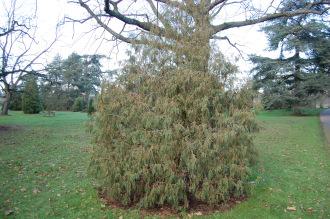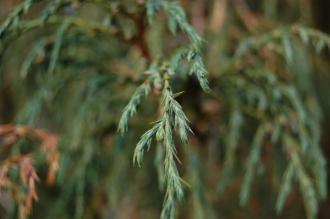
Juniperus recurva (30/12/14, Kew Gardens, London)
Position: Full sun
Flowering period: Early Spring
Soil: Moist, well drained
Eventual Height: 10m
Eventual Spread: 6m
Hardiness: 7a, 7b, 8a, 8b, 9a, 9b, 10a
Family: Cupressaceae
Juniperus recurva is a slow growing, evergreen large shrub or small tree with an irregular conical habit. Its blue/ green leaves are sharp, needle like and up to 6mm long. Its foliage is notably pendulous. Its bark is grey/ brown and flaking. Its trunk may achieve a diameter of up to 2m. Its (usually) monoecious male flowers are pollen cones, are light brown, up to 4mm long, wind pollinated and are not self fertile. Its blue/ black fruit are a berry like seed cone, are globose and up to 7mm across.
Juniperus recurva, commonly known as Drooping Juniper or Himalayan Weeping Juniper, is native to the north of the Himalayas. In its native habitat it grows in woodlands and thickets at an altitude of 1800m to 3900m.
The etymological root of the binomial name Juniperus is derived from the old Latin name for the Juniper tree. Recurva is derived from the Latin recurvo meaning ‘bend back’.

Juniperus recurva Leaf (30/12/14, Kew Gardens, London)
The landscape architect may find Juniperus recurva useful as a evergreen shrub or small tree with an attractive drooping habit.
Ecologically, Juniperus recurva seed cones are attractive food for birds and mammals. Its structure provides shelter for birds.
Juniperus recurva prefers moist, fertile, well-drained soils. It will tolerate most pH of soil.
Juniperus recurva requires little maintenance.

